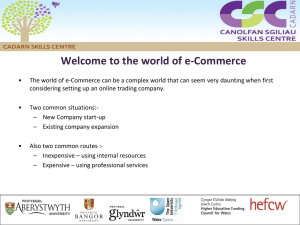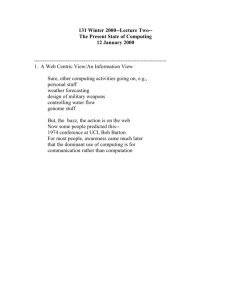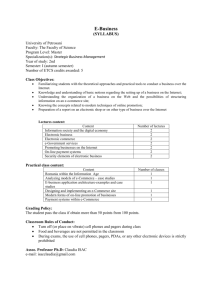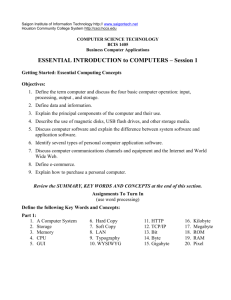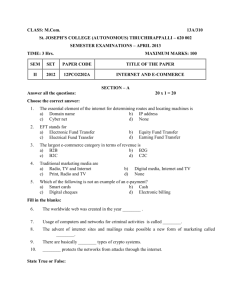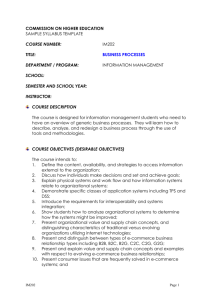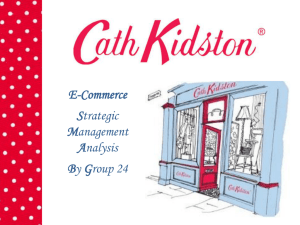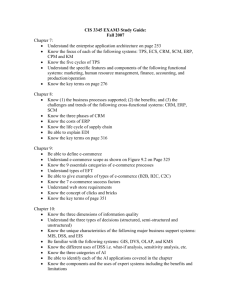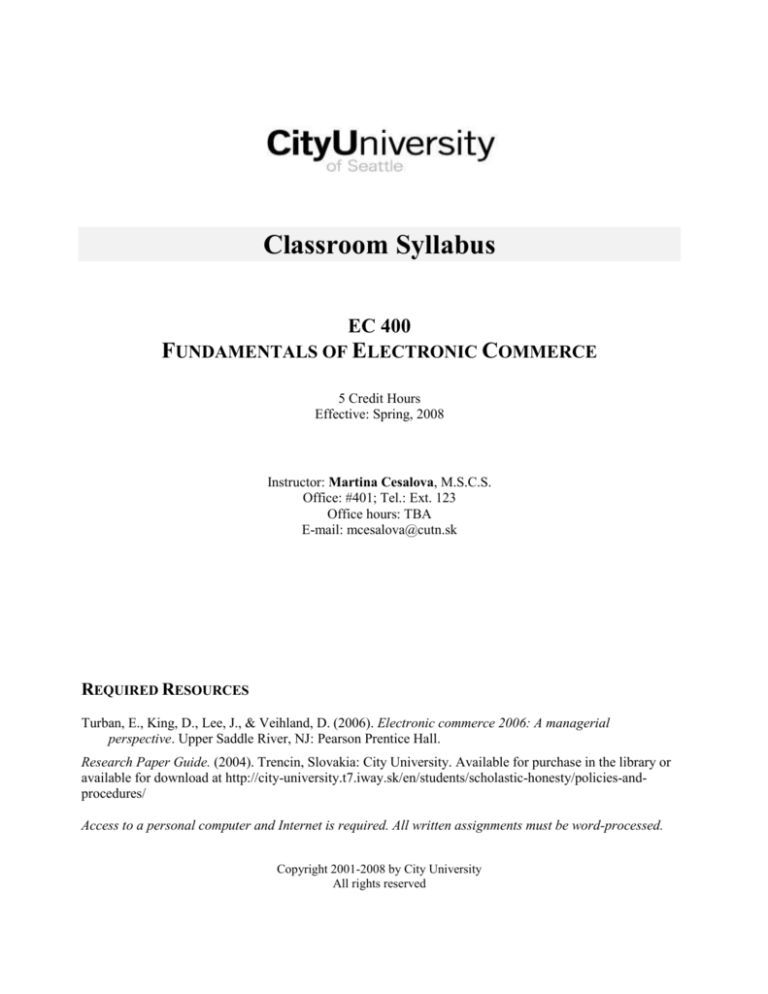
Classroom Syllabus
EC 400
FUNDAMENTALS OF ELECTRONIC COMMERCE
5 Credit Hours
Effective: Spring, 2008
Instructor: Martina Cesalova, M.S.C.S.
Office: #401; Tel.: Ext. 123
Office hours: TBA
E-mail: mcesalova@cutn.sk
REQUIRED RESOURCES
Turban, E., King, D., Lee, J., & Veihland, D. (2006). Electronic commerce 2006: A managerial
perspective. Upper Saddle River, NJ: Pearson Prentice Hall.
Research Paper Guide. (2004). Trencin, Slovakia: City University. Available for purchase in the library or
available for download at http://city-university.t7.iway.sk/en/students/scholastic-honesty/policies-andprocedures/
Access to a personal computer and Internet is required. All written assignments must be word-processed.
Copyright 2001-2008 by City University
All rights reserved
EC 400
FUNDAMENTALS OF ELECTRONIC COMMERCE
This document provides an overview of the course foundation elements, assignments, schedules, and
activities. For information about general City University policies, please see the City University catalog. If
you have additional questions about the course, please contact your instructor.
NOTIFICATION FOR STUDENTS WITH DISABILITIES
If you are a student with a disability and you require an accommodation, please contact the associate dean
as soon as possible.
SCHOLASTIC HONESTY
Scholastic Honesty City University of Seattle expects each student to do his/her own work. The
University has "zero tolerance" for cheating, plagiarism, unauthorized collaboration on assignments and
papers, using "notes" during exams, submitting someone else's work as one's own, submitting work
previously submitted for another course, or facilitating acts of academic dishonesty by others. The
penalties are severe! A first offense can result in a zero grade for the course and suspension for one
quarter; a second offense can result in a zero grade for the course and suspension for two or more quarters;
a third offense can result in expulsion from the University. The Policy and Procedures may be found at
http://city-university.t7.iway.sk/en/students/scholastic-honesty/policies-and-procedures/ or
www.cutn.sk/SH
In addition to providing your work to the instructor for grading, you must also submit an electronic copy
for the City University of Seattle archives (unless the work is specifically exempted by the instructor). You
will not receive a grade for particular work until and unless you submit this electronic copy. The procedure
for submitting work to the archives is to upload it via the website http://bb.cutn.sk/cgi-bin/new_upload.pl or
www.cutn.sk/Upload. Files should include the cover page of the work with the student name, instructor
name, course name and number, and date. File names should indicate the type of assignment, such as
“researchpaper.doc”, “casestudy.doc” or “ thesis.doc” (student name should not be a part of the file name
because the system adds it). All files received into the archives are submitted to www.TurnItIn.com for
plagiarism checking.
COURSE DESCRIPTION
This course provides an overview of Electronic Commerce (E-Commerce) from a managerial perspective.
Areas covered include: Business-to-Consumer, Business-to-Business, Business-to-Employee, and the EEnvironment. The course also includes topics such as: E-Commerce intermediaries and business models,
technologies that enable E-Commerce; consumer behavior, site design, site promotion, business challenges,
and strategies. It will provide students with knowledge of web site use, challenges and strategies for
reaching customers, and how E-Commerce works in the business environment today.
LEARNING GOALS
Upon the successful completion of this course, you will be able to:
1. Define E-Commerce and describe its various categories;
2. Describe and discuss the content and framework of E-Commerce;
EC 400
SYL
Page 2
Eff: 04/08
3. Describe the major managerial issues regarding E-Commerce;
4. Analyze the roles of the intermediaries that enable E-Commerce;
5. Explain the functionality of the key technologies that enable E-Commerce;
6. Compare and contrast the different architectures used for E-Commerce;
7. Explain the different E-Commerce models;
8. Differentiate various types of e-customers;
9. Evaluate various techniques for site design and promotion;
10. Analyze various business strategies used for E-Commerce.
CORE CONCEPTS
To achieve the goals of this course, you will need to master the following core concepts:
1. Foundation of E-Commerce;
2. E-Marketplaces;
3. Supply and value chains;
4. Retailing in E-Commerce;
5. Consumer behavior;
6.
Advertisement in E-Commerce;
7. Company-centric B2B;
8. Public B2B Exchanges & Portals;
9. E-Supply Chains & Intra-business E-Commerce;
10. E-Government & E-Learning;
11. Building E-Commerce applications;
12. E-Commerce security;
13. Electronic payment systems;
14. Order fulfillment, logistics, and supply chain management;
15. E-Commerce strategies and implementation;
16. E-Commerce Business plan formation;
17. Fundamentals of building a storefront;
18. E-commerce web site design & creation;
19. The regulatory environment of E-Commerce;
20. E-Commerce applications & infrastructure.
EC 400
SYL
Page 3
Eff: 04/08
RECOMMENDED SUPPLEMENTARY RESOURCES
As a City University of Seattle student, you have access to library resources regardless of where and how
you are taking this class. To access the resources necessary to complete your coursework and assignments,
visit the library menu in the My.CityU portal at https://my.cityu.edu, and the CU Slovakia library home
page at http://www.cutn.sk/ .
Search the local library's online catalog to locate books. Search the online databases for journal, magazine,
and newspaper articles. Articles that are not available in full text in the library's collection can be requested
from other libraries and delivered to you electronically. For additional help, visit the library or submit your
question at Contact Us in the Slovakia library web site.
PRINT RESOURCES
Award, E. M. (2003). Electronic Commerce (2nd Ed.). New Jersey: Prentice Hall.
Butte, F. (2003). Customer relationship management: concepts and tools. New York: butterworthHeinemann
Holden, G. (2002). Starting an online business for dummies (3rd Ed.).
Monk, E., & Wagner, B. (2005). Concepts in enterprise resource planning (2nd Ed.). New York: Course
Technology.
Sumner, M. (2004). Enterprise resource planning. New Jersey: Prentice Hall.
Wallace, P. (2004). The internet in the workplace: how new technology is transforming work. United
Kingdom: Cambridge University Press.
ELECTRONIC RESOURCES
The City University Library provides access to a variety of online databases that contain both abstracts
(brief summaries) and full text (the complete text) of journal, magazine, and newspaper articles. The
following is a partial list of databases that may be of use to you in this course. A complete list can be found
by visiting the library menu in the My.CityU portal at https://my.cityu.edu. Contact a librarian by e-mailing
library@cityu.edu if you need help searching or logging in.
The following general Internet World Wide Web resources may be of use to you in this course. Please be
aware that Web addresses may change from time to time.
City University Online Databases -- Business Databases, Computer Databases
https://my.cityu.edu
Brint – Knowledge Management
http://www.brint.com/OrgLrng.htm
ClickZ Today
http://www.clickz.com
CRM Today
http://www.crm2day.com/crm_articles/
Ecommerce-Guide.Com
http://ecommerce.internet.com
EC 400
SYL
Page 4
Eff: 04/08
Ecommerce Times
http://www.ecommercetimes.com
Informit
http://www.informit.com/articles/index.asp?st=41461&rl=1
InfoWorld
http://infoworld.com
KM Frequently Asked Questions – University of Texas at Austin
http://www.mccombs.utexas.edu/kman/answers.htm
Knowledge Management
http://www.destinationkm.com/
Internet World
http://iw.com
PC Magazine
http://www.zdnet.com/pcmag
OVERVIEW OF COURSE ACTIVITIES AND GRADING
The grade you receive for the course will be derived using City University’s decimal grading system, based
on the following:
Assignments
Lab Assignments (two equally weighted)
Case Analysis
Tests (two equally weighted)
EC Store Project
EC Store Project Presentation
20%
15%
30%
20%
15%
TOTAL
100%
Please see the current City University catalog or consult your instructor for guidance in determining your
decimal grade.
EXPLANATION OF ASSIGNMENTS AND GRADING
LAB ASSIGNMENTS
To fulfill the requirements of this course, you will need to successfully complete two practical assignments.
These assignments will demonstrate your knowledge of Internet technology that pertains to E-Commerce,
computer skills, and your knowledge of the practical course content. The first assignment will focus on the
topics covered in the first three weeks and the second will focus on topics covered in the fifth and sixth
week. (Exact topics will be specified by instructor.)
EC 400
SYL
Page 5
Eff: 04/08
Grading Criteria for Lab Assignments
Implementation of course concepts
Following the given instructions
Professionalism
Validity & completeness of the outcome
25%
20%
30%
25%
TOTAL
100%
CASE ANALYSIS
Your instructor will give you guidelines to use in selecting a case for analysis. A case analysis is designed
to help you sharpen your analytical skills. The strongest way to analyze a case is to apply a variation of the
scientific method. This method of analysis is simply a logical approach that usually includes the seven steps
outlined below.
Step 1: Problem Definition
A case seldom involves one clear-cut problem. Your task is to:
Determine the symptoms which require immediate attention.
Identify the fundamental issues and causal factors giving rise to these symptoms.
It is important to separate the immediate problems from their more basic sources. For example, the
immediate problem may be a high rate of absenteeism, while the more fundamental issue may be a poor
motivational climate. How you define a problem determines how you go about solving it. A short-term
solution for absenteeism is likely to be different from solutions that attempt to deal with motivational
climate. Be sure to identify both the symptom and, more importantly, its underlying cause.
Step 2: Justification for Problem Definition
In this step you need to review the information you have about the problem. You may need to make some
inferences to fill in gaps. Clearly label what is inference and what is factual. Do not be afraid to assume, but
clearly state the assumptions you are making. You should make assumptions on the basis of your
knowledge of typical managerial practices, and they should be consistent with the facts about the case, even
though your facts may be somewhat limited. Managerial decisions are often based on limited information.
In fact, practicing managers find that many of their decisions have to be made quickly on the basis of
limited information.
Step 3: List Alternative Courses of Action
Be creative. Jot down ideas as they come to you. List as many ideas as you can without evaluating them or
censoring anything. You can always cross them out later. The point is to let your imagination take over.
Step 4: Evaluate Alternatives
Look critically at the alternatives you came up with in Step 3. List advantages and disadvantages of each
alternative in terms of criteria that seem appropriate.
Step 5: Review
Reread your notes and think. This may be a good time to let the case sit for a while. Get back to it later
when you have a chance to digest all the data.
Step 6: Draw Conclusions, Make Recommendations/Decisions
Select the alternative you would recommend and explain/justify your choice. Include specifics about the
implementation of your recommendation: who should do what, when, and how.
EC 400
SYL
Page 6
Eff: 04/08
Step 7: Follow Up and Evaluate
Given the limitations of a classroom setting, you cannot implement your recommendation and evaluate its
actual impact. However, in this step you will describe how you would set up an evaluation procedure.
Suggest a timetable and methods for the evaluation process. State who should do the evaluating.
Source: Myers, T., & Myers, G. (1982). Managing by communication: An organizational approach. New York: McGraw-Hill Book.
You must follow the APA style (the guide is available for download at http://cityuniversity.t7.iway.sk/en/students/scholastic-honesty/policies-and-procedures/) and upload this assignment (via
www.cutn.sk/upload or http://bb.cutn.sk/cgi-bin/new_upload.pl).
Grading Criteria for Case Analysis
Integration of course concepts
Completeness of analysis
Logically supported conclusions, recommendations
Sufficient bibliographic support
Proper grammar, spelling, punctuation, and syntax
25%
30%
25%
10%
10%
TOTAL
100%
TESTS
You should be prepared to answer a variety of types of questions pertinent to the concepts covered in or
suggested by the course materials, assignments and activities. Your instructor may provide you with
additional information about the content, style, and grading criteria of tests in this course.
Grading Criteria for Essay Questions on the Tests
Clear grasp of major issues posed by the question
Valid arguments; appropriate supportive detail
Appropriate analysis, evaluation, and synthesis
Demonstrated ability to employ terms, concepts, and frames of
reference from texts, lectures, and other course materials
Proper organization and logical flow of responses
20%
20%
20%
20%
TOTAL
100%
20%
EC STORE PROJECT –BUSINESS PLAN OUTLINE
Using the EC Store Project assignment description, provide 3-4 paragraphs summarizing your product
concept/idea for the EC Store Project and an outline of your business plan. This outline is not graded, it is
so your instructor can provide you with feedback and ensure students are on the right track.
EC STORE PROJECT
You will be developing a new online business using FrontPage. The objective of this project is to develop
(in a limited way) an E-Commerce business using what you've learned and applying it through the
decision-making processes necessary. You will also need written documentation to support your online
store (see outline below). There are two parts to this assignment: E-Store and Business Plan.
The following information about your business/store should be included in a business plan proposal:
EC 400
SYL
Page 7
Eff: 04/08
Identify a viable business or store and include a justification for it;
Choose a name for your EC Store;
Create a Mission Statement, Goals, and Vision for your product concept;
Identify your target customers and their wants and needs (what would motivate them to purchasing
from your store?);
Who is your competition?
How will you advertise or communicate your business to customers?
What payment system options will you accept?
What might be your supply chain management (who might be your vendors)?
Your web site should include:
7 sections or categories or departments minimum;
10 products with some graphics and detailed info;
Pricing information;
Contact information;
“About” section with Mission Statement, Goals, and Vision (can include history, etc.);
Interactive online shopping site (developed in a limited way);
Dynamic elements (designed by e.g. JavaScript);
Clear navigation (using 2nd level hyperlinks);
Evidence of design, aesthetics, and usability considerations.
You will turn in the following:
Business Plan;
EC Store Project created using: MS FrontPage
Grading Criteria for EC Store Project
Integration of course concepts
Originality and professionalism
EC Store web site concept and design
Business Plan – written documentation supporting EC Store
TOTAL
15%
25%
35%
25%
100%
You must upload the business plan! (via www.cutn.sk/upload or http://bb.cutn.sk/cgi-bin/new_upload.pl).
EC 400
SYL
Page 8
Eff: 04/08
EC STORE PROJECT PRESENTATION
You will deliver an oral presentation of your EC project in class. Your presentation will be about 10
minutes in length; will be supported by a PowerPoint slideshow and a brief demonstration of the E-Store
web site. Presentations will be due individually, as assigned.
This assignment will be graded according to the following criteria:
Grading Criteria for Report and Presentation
Persuasiveness and valid arguments
Demonstrated ability to employ course terms and concepts
Organization: simplicity, timing and clarity
Slide show and EC store demonstration
Appearance, voice, and non-verbal communication
TOTAL
20%
20%
20%
20%
20%
100%
CLASS PARTICIPATION AND ATTENDANCE
Attendance at all scheduled course meetings is strongly encouraged! The students are allowed to miss 12
class sessions during the term. Any additional absence means subtraction of 10% from your TOTAL grade.
If you miss a class, however, it is your responsibility to get the classroom information. Also, please, note
that late assignment submissions will NOT BE ACCEPTED!
Student Behavior
Students who come to class will be expected to listen and to participate fully in classroom
discussions of the course material and in class assignments. Disruptions of the lecture or
discussion of the material will not be tolerated. Disruptions of the lecture and classroom
discussion include:
Being late for class
Continuous talking, laughing
Talking while instructor is lecturing or when other students are speaking and expressing
their ideas
Reading newspapers, magazines, journals, books, etc. not related to the course
Listening to music
Sleeping or resting
Wandering in and out of class without permission
Chatting, e-mailing or using the Internet for private purposes
Students who disrupt the class will be asked to leave the classroom and will be marked absent.
Mobile phones must be TURNED OFF for the duration of all lessons and put away.
NO SMS during class!
EC 400
SYL
Page 9
Eff: 04/08
RECOMMENDED COURSE SCHEDULE
The schedule for course activities and assignments is below.
SESSION
1
2
3
4
5
6
7
8
9
TOPICS AND ASSIGNMENTS
READINGS
Overview of Electronic Commerce
E-Marketplaces: Structure, Mechanisms, Economics,
and Impacts
Retailing in Electronic Commerce: Products and
Services
Consumer Behavior, Market Research, and
Advertisement
B2B-Commerce: Selling and Buying in Private EMarkets
Public B2B Exchanges and Support Services
E-Supply Chains, Collaborative Commerce,
Intrabusiness EC, and Corporate Portals
Supply Chain Management
DUE: Lab Assignment 1
Innovative EC Systems: From E-Gov and E-Learning
to C2C
Mobile Commerce and Pervasive Computing
E-Auctions
E-Commerce Security
DUE: Test 1
Ch. 3 and 4
Ch. 5, 6, and 7
Ch. 8 and 9
Ch. 10 and 11
Electronic Payment Systems
Order Fulfillment, eCRM, and Other Support Services
E-Business Plan
DUE: Lab Assignment 2
E-Commerce Strategy and Global EC
Economics and Justification of Electronic Commerce
Web Page Design and Creation
DUE: Case Analysis
Launching a Successful Online Business and EC
Project
Infrastructure for Electronic Commerce
DUE: Test 2
EC Store Project
Attendance on all scheduled lectures required!
DUE: EC Store Project: project & business plan
10
DUE: EC Store Project Presentation
EC 400
Ch. 1 and 2
SYL
Page 10
Eff: 04/08
Ch. 12 and 13
Ch. 14 and 15
Ch. 16

